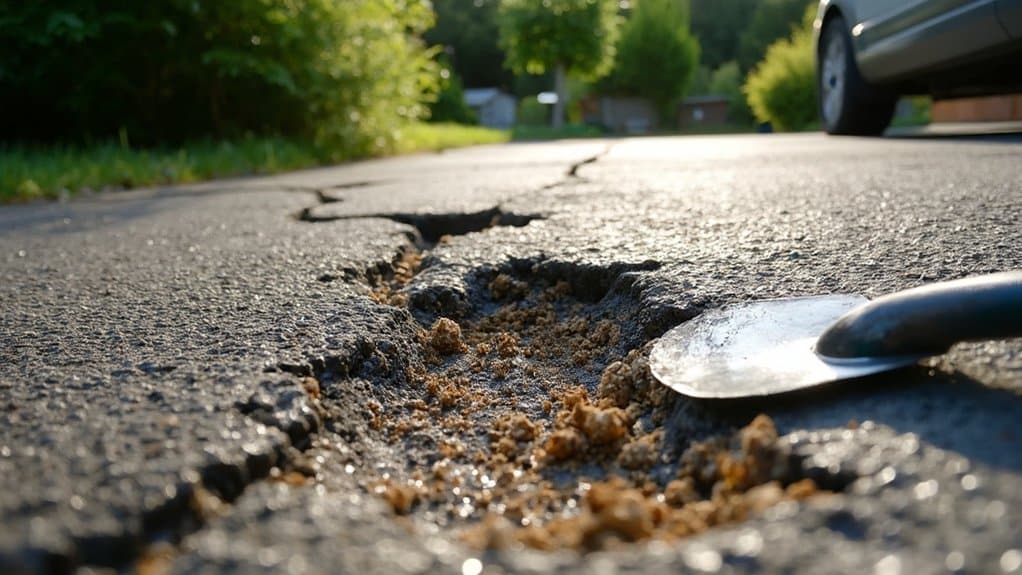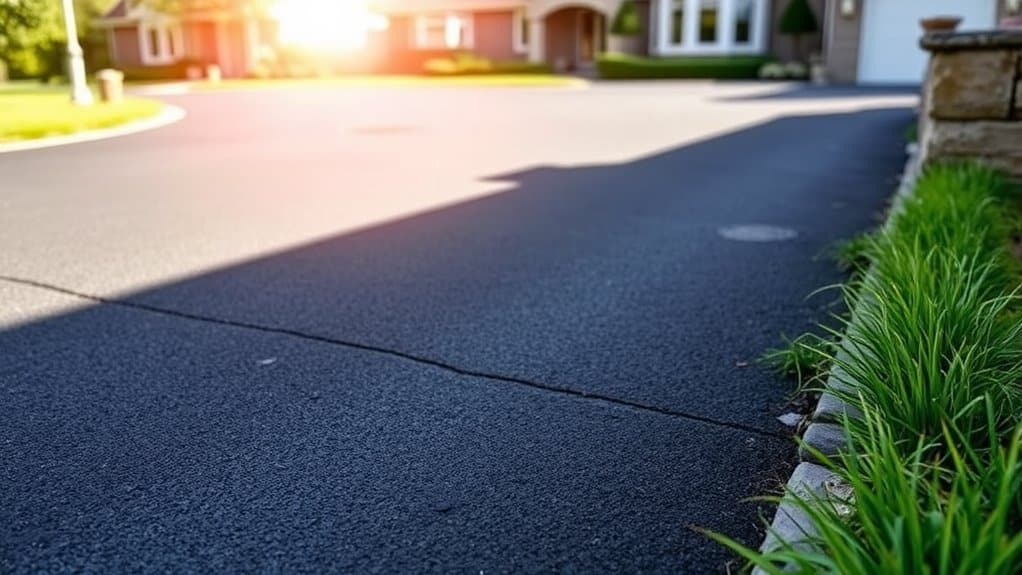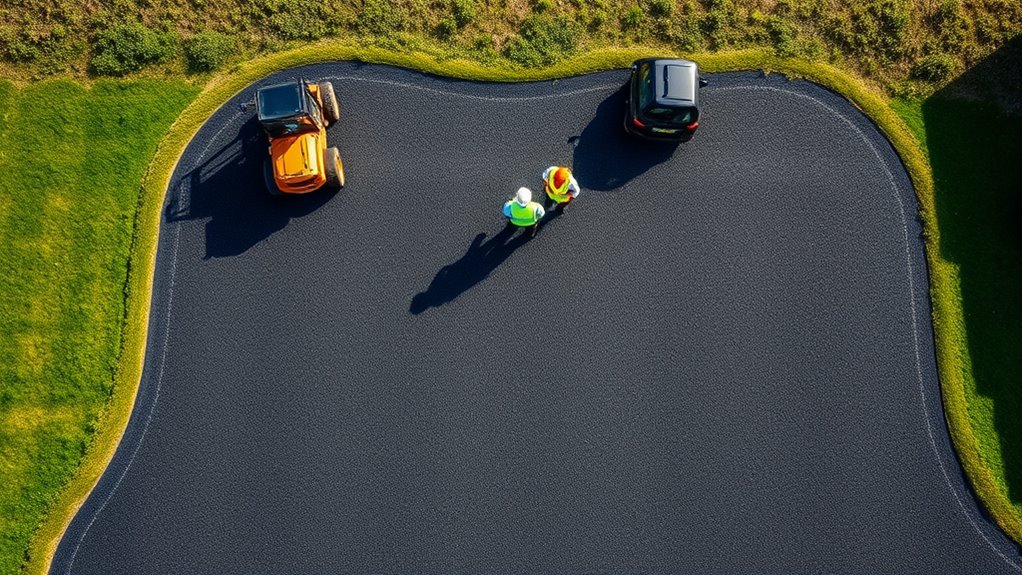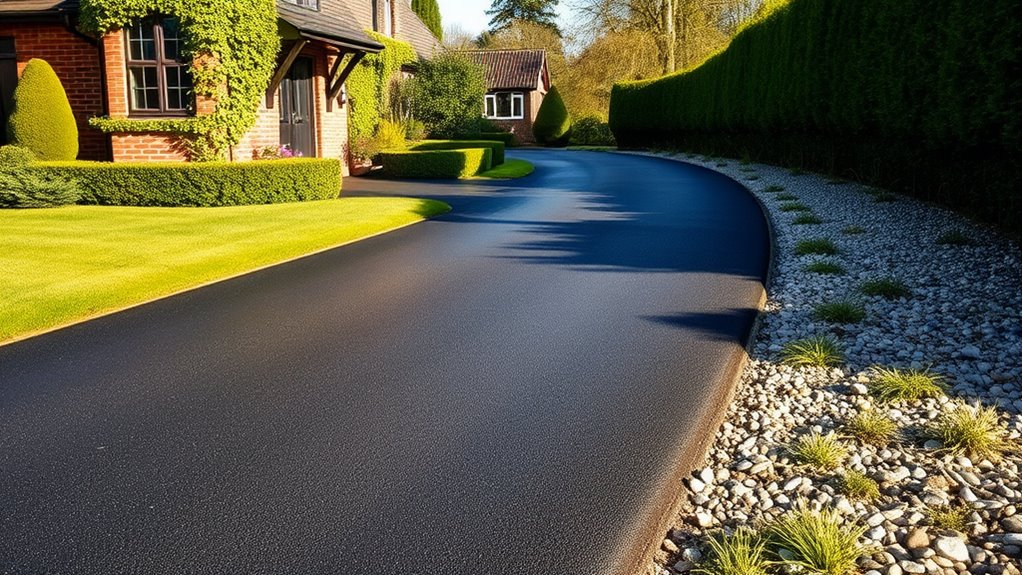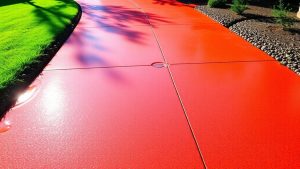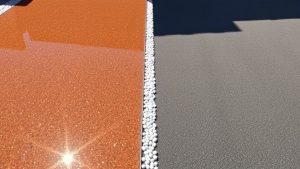Tarmac driveways often face problems like cracks, potholes, and drainage issues. For cracks, check their size and use suitable fillers to repair them. Potholes need to be cleared out, compacted, and then filled with repair materials. It’s essential to maintain proper drainage to prevent water accumulation, which can damage the base. Regular cleaning and sealing every few years will boost durability and help prevent weeds from growing. By tackling these issues early, you can keep your driveway in top shape and extend its life. There’s much more to explore regarding effective maintenance tips.
Table of Contents
ToggleKey Takeaways
- Regularly check for cracks; use the right fillers for different crack widths to stop them from worsening.
- Tackle potholes quickly by evaluating their size, clearing out debris, and applying repair materials in layers for a solid fix.
- Ensure proper drainage to avoid standing water, which can compromise the driveway’s structure.
- Seal the tarmac every 2-5 years to boost its lifespan and shield it from the elements.
- Keep the surface clean to eliminate debris and stop weeds from sprouting, ensuring your driveway lasts longer.
Durability Concerns and Maintenance Needs
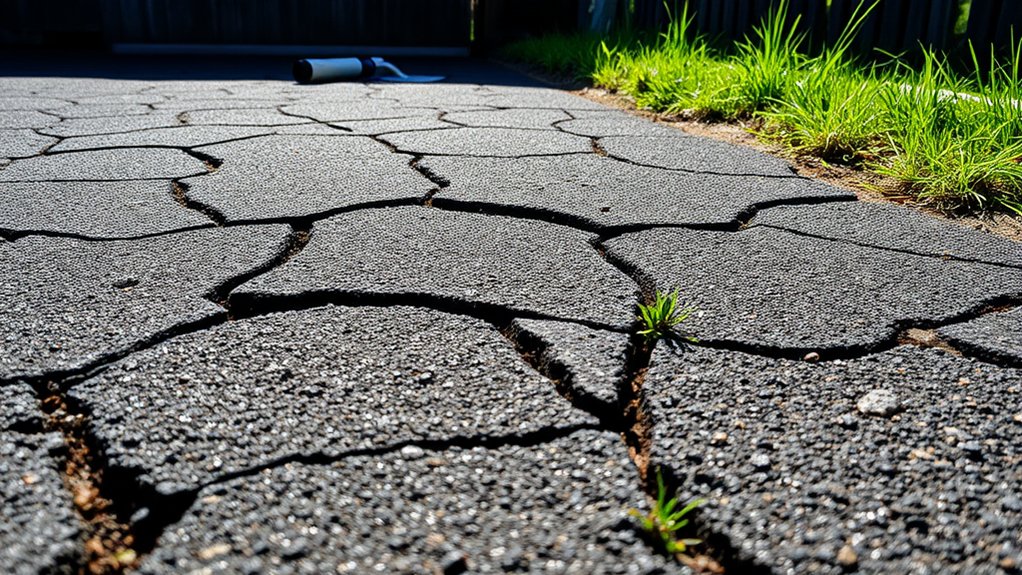
Tarmac driveways are popular for their affordability and quick installation, but their durability depends on a few key factors. For instance, temperature changes can cause the tarmac to soften or harden, leading to cracks if not addressed. Heavy traffic, particularly from large vehicles, can accelerate wear and tear, while the quality of materials and installation plays a crucial role in longevity. To improve durability, it’s wise to seal the surface every 2-5 years, keep it free of debris, and regularly check for cracks. Ensuring proper drainage is also vital, as standing water can weaken the base. Additionally, regular inspections can help identify potential issues before they escalate. By managing vehicle loads and being proactive about maintenance, you can significantly extend the life of your tarmac driveway. Regular upkeep is essential for optimal performance and longevity, as proper maintenance can help ensure the driveway lasts longer than the average lifespan of 12-13 years.
Understanding Cracks in Tarmac Driveways
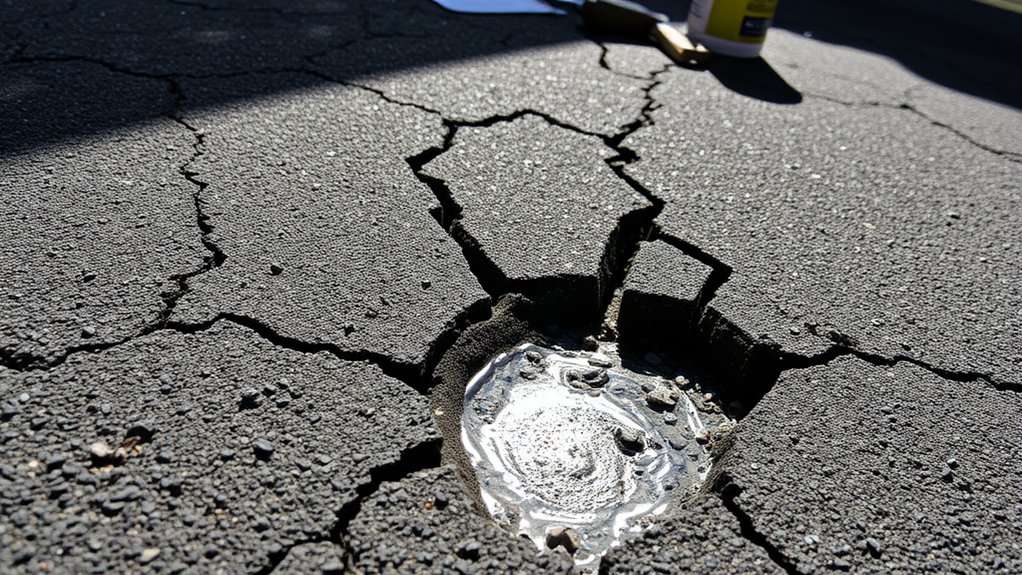
Understanding the causes of cracks in your tarmac driveway is crucial for proper maintenance and repair. Issues like poor installation, fluctuations in weather, and heavy vehicles can lead to considerable damage if not dealt with quickly. For instance, a poorly laid driveway might crack under the weight of a family car, while freezing temperatures can cause surface damage. Additionally, poor drainage systems can exacerbate cracking by allowing water to accumulate and weaken the tarmac over time. Regular inspections can help identify potential underlying issues before they escalate into major problems.
Causes of Cracking
Tarmac driveways are susceptible to cracking due to several factors that can undermine their strength over time.
Weather is a major influence; significant temperature fluctuations can cause the tarmac to expand and contract, resulting in cracks. Heavy traffic puts additional stress on the surface, which can worsen the cracking.
Installation issues, like inadequate compaction or the use of subpar materials, can weaken the foundation and make it more vulnerable to damage. Alligator cracking is particularly common in areas with poorly compacted bases, leading to multiple cracks resembling scales. Poor drainage can lead to water pooling, which may freeze and create further cracks. As tarmac ages, it naturally becomes brittle, increasing the risk of different types of cracks, such as edge, longitudinal, and fatigue cracks. Understanding freeze-thaw cycles is essential for maintaining the driveway’s integrity as these cycles contribute to the deterioration of the surface.
Being aware of these causes can help you take steps to maintain your driveway and prevent costly repairs.
Repair Techniques Overview
When assessing cracks in a tarmac driveway, it’s important to determine their severity to select the right repair method. Start with a visual inspection and use tools to measure the depth and width of the cracks. Based on your findings, choose the appropriate filler.
| Severity Level | Crack Width | Recommended Filler |
|---|---|---|
| Small | Less than 6 mm | Cold Pour Crack Fillers |
| Medium | 6 mm to 12 mm | Rubberised Asphalt Filler |
| Large | More than 12 mm | Tarmac Patching Compounds |
| Deep | Variable | Pli-Stix Hot Filler |
Before applying any filler, ensure the area is thoroughly cleaned, and allow sufficient drying time. Regular maintenance is key to preventing future problems and extending the lifespan of your driveway.
Addressing Potholes Effectively
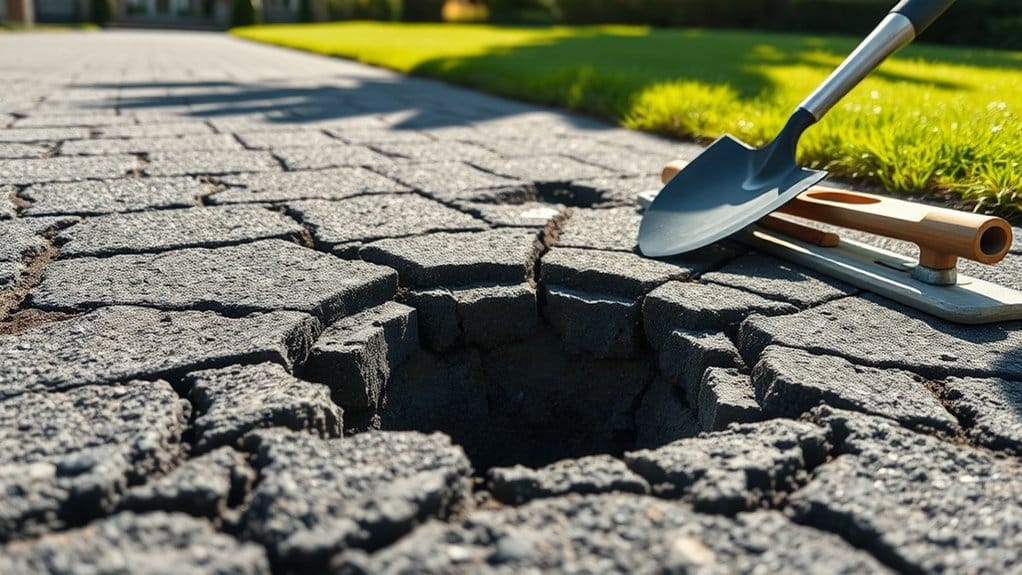
Effectively addressing potholes requires a systematic approach to assessment and repair. Start by assessing the pothole: measure its size and depth to decide if a DIY repair is possible. For small potholes, cold lay tarmac works well, while larger or deeper ones may need hot asphalt for a durable fix.
Check the surrounding area for additional damage too.
Next, prepare the pothole by clearing away debris and compacting the base. Apply the repair materials in layers, compacting each layer to ensure stability.
Lastly, allow enough time for the repair to set before allowing traffic back on the surface. By following these steps, you can significantly prolong the life of your tarmac driveway and help prevent further damage.
Managing Weeds and Moss Growth
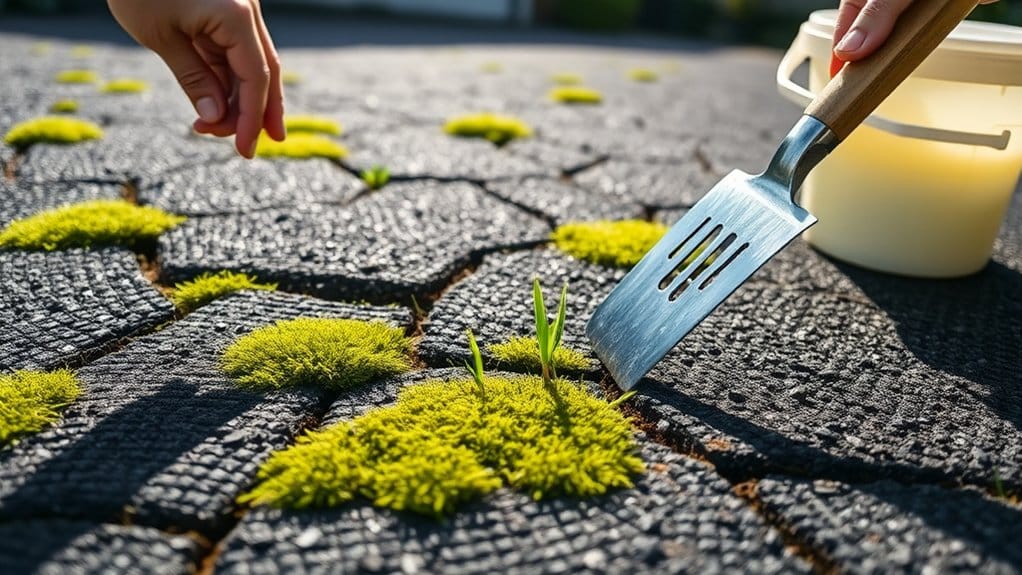
Managing weeds and moss on a tarmac driveway is crucial for maintaining its appearance and longevity. Start with a proper installation that includes a weed control membrane to minimise future growth.
Regularly check for emerging weeds, so you can remove them quickly. Natural remedies like boiling water or vinegar can effectively kill weeds without resorting to harmful chemicals.
For moss, power washing can work well, but be careful not to damage the tarmac surface. Regular upkeep, such as sealing cracks, helps prevent moisture build-up, which discourages further growth.
Proactively addressing these issues not only saves you time and money but also enhances the overall look and durability of your driveway. Don’t forget to keep an eye on shaded areas and nearby plants that may encourage weed growth.
Solving Drainage Issues
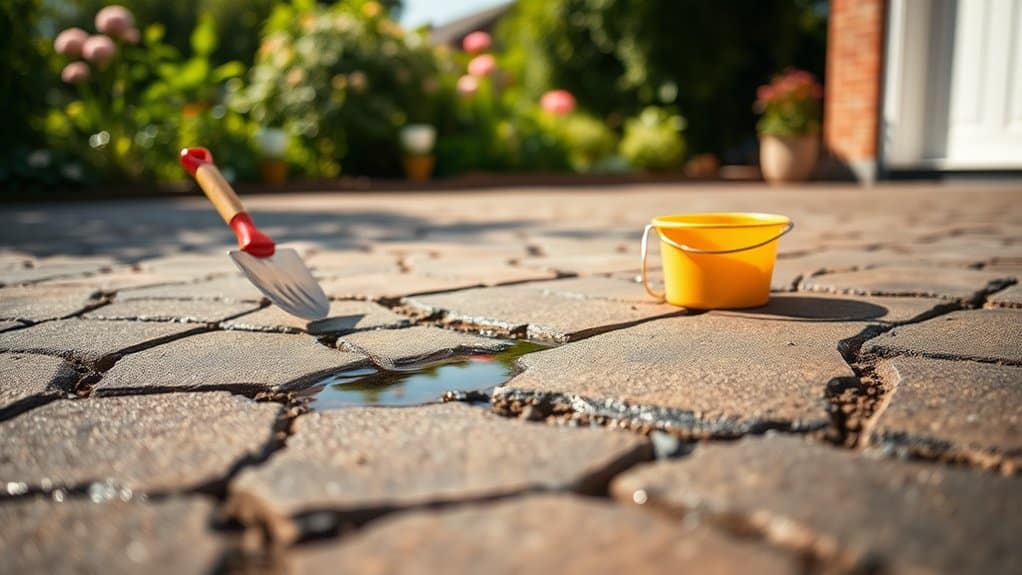
Proper drainage is crucial for preserving your tarmac driveway, as poor water management can cause significant damage over time.
Start by checking the slope and grading; it should direct water away from your home to prevent pooling. Regularly clear any blockages in gutters and downspouts, as these can worsen drainage issues.
Consider installing drainage solutions such as channel drains or French drains to effectively manage surface and subsurface water. If your soil is heavy in clay, which can hinder absorption, you may need to improve it for better drainage.
Lastly, keep an eye out for puddles or cracks on your driveway, as these are signs of drainage problems that need prompt attention to prevent further damage.
Maintenance and Prevention Strategies
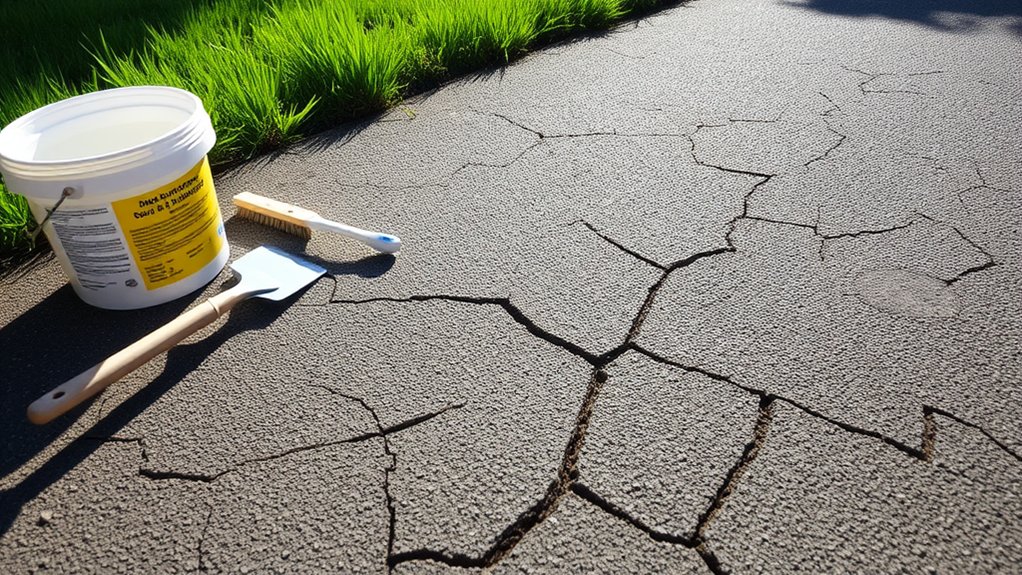
To keep your tarmac driveway looking its best and extend its lifespan, proactive maintenance is essential. Here are three key strategies to consider:
- Regular Cleaning: Frequently remove leaves and debris. Use a mild cleaner and a low-pressure hose to avoid damaging the surface.
- Crack Prevention: Regularly check for cracks and seal them promptly. Applying a seal coat every 3-5 years will protect your driveway from UV damage and water ingress.
- Weed Control: Sweep the surface regularly to prevent weeds from taking root. Consider using eco-friendly moss treatments to keep the area tidy without harming the tarmac.
Frequently Asked Questions
How Long Does a Tarmac Driveway Typically Last?
A tarmac driveway usually lasts between 15 to 20 years, depending on the quality of installation and how well it’s maintained. Regular inspections and sealing can significantly extend its lifespan, helping you get the most out of your investment.
Can I Install a Tarmac Driveway Myself?
You can try to install a tarmac driveway yourself, but it can be tricky without experience and the right tools. To ensure longevity and avoid problems down the line, regular maintenance is crucial. For the best results, it’s often wise to hire professionals.
What Is the Best Time of Year for Installation?
The ideal time for tarmac installation is from late spring to early autumn. It’s best to aim for temperatures between 10°C and 32°C. Be mindful that rain and high humidity can interfere with the process, impacting adhesion and compaction. For example, if it rains during installation, it can lead to a weaker surface that may not last as long.
How Can I Improve My Driveway’s Appearance?
Improving your driveway’s appearance is straightforward. Begin with a thorough clean to remove dirt and stains, then apply a sealant for a smooth finish. These steps not only boost the lifespan of your driveway but also significantly enhance your home’s curb appeal. Consider using a pressure washer for effective cleaning and choose a sealant that suits your driveway’s material, whether it’s tarmac, block paving, or concrete.
Are There Eco-Friendly Options for Tarmac Driveways?
Yes, there are eco-friendly options for tarmac driveways. You can use sustainable materials like recycled asphalt, which reduces environmental impact and improves durability. This approach not only provides a responsible solution but can also enhance the look of your driveway.
Conclusion
When dealing with common tarmac driveway issues, you’re ensuring its durability and practicality. By addressing cracks, potholes, and drainage problems, you’re not only protecting your investment but also improving your home’s curb appeal. Ignoring these matters can lead to bigger headaches down the line. Regular maintenance and proactive measures will help your driveway last longer and continue to impress for years.
Just how long can you expect your tarmac driveway to last? Discover key factors and maintenance tips that can extend Read more
From planning to final touches, discover the essential steps of tarmac driveway installation—what could go wrong if you skip any Read more
Wondering if a tarmac driveway is the perfect fit for your home? Uncover the essential pros and cons before making Read more

